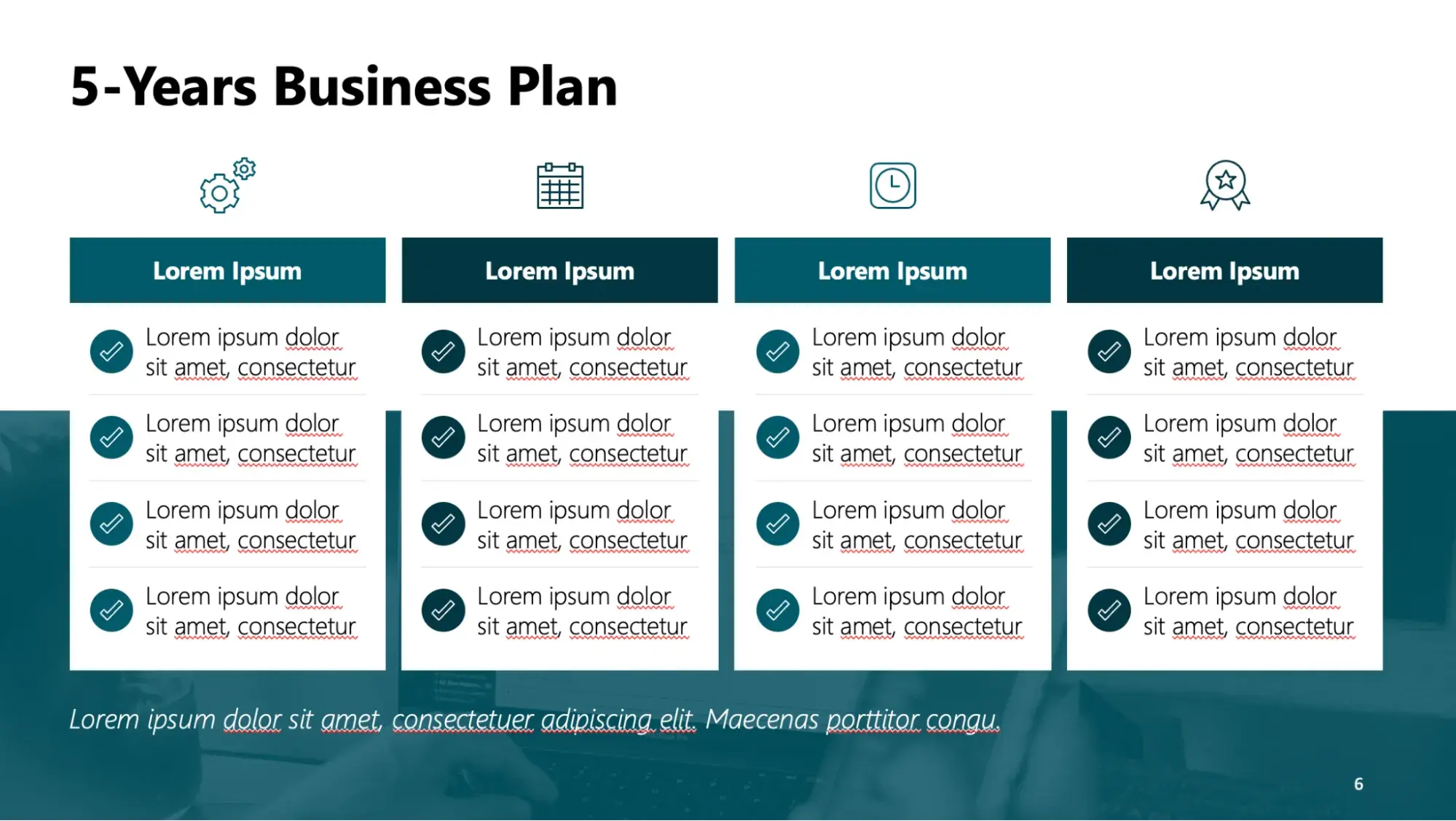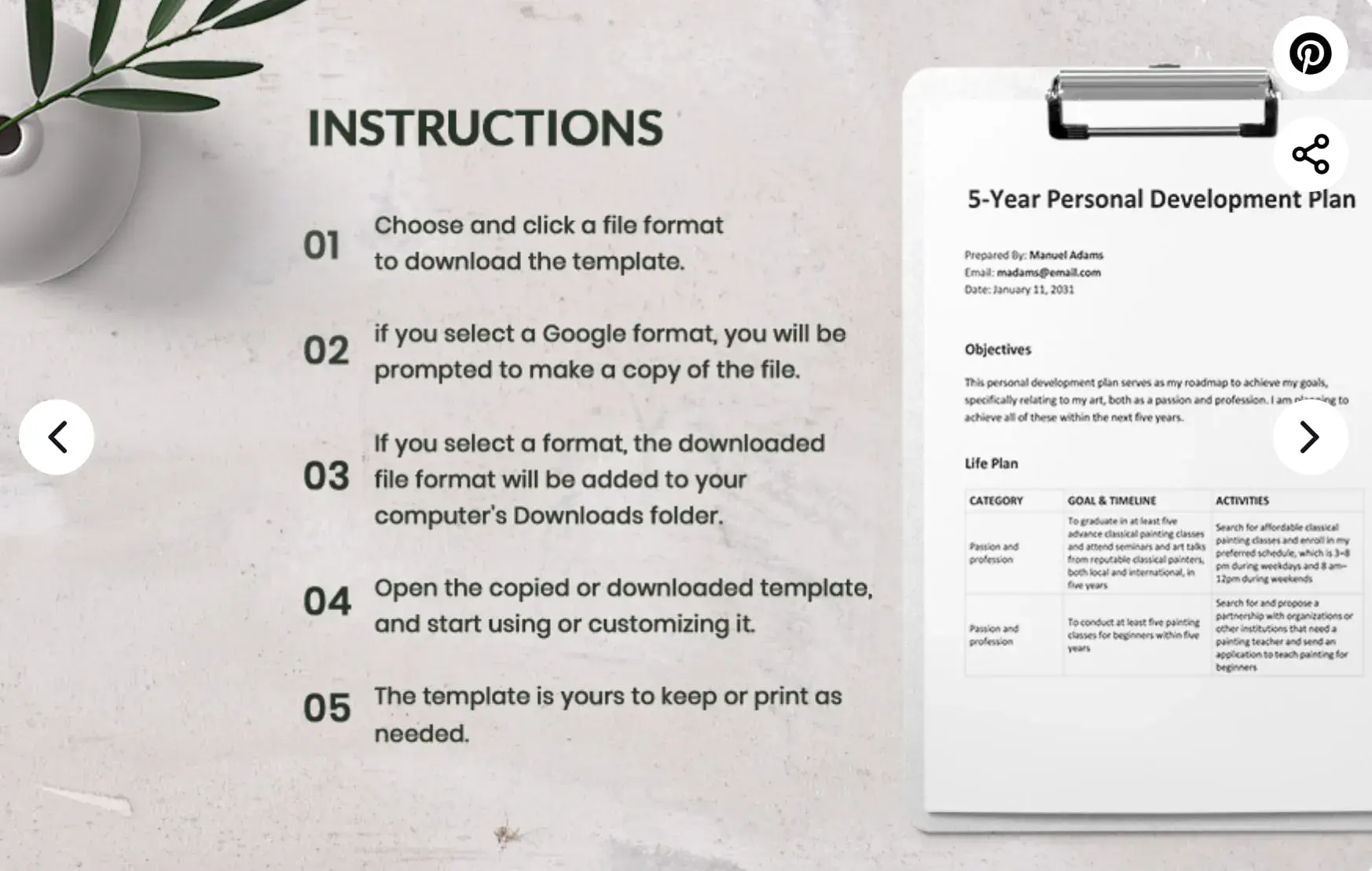I’ve also had lengthy internal monologues about whether I want to buy a house, the countries I want to travel to, and the mountains (literal and figurative) I want to climb.
However, a desire without a plan is just a dream. I want to make sure I make my long-term goals a reality. That’s why I love five-year plans. That’s enough time to take the steps to prepare for lofty accomplishments.
So, in this post, I’ll share my tips for creating five-year plans that you can actually stick to. I’ll also share examples of what these steps look like in practice. Let’s dive in.
Table of Contents
Benefits of a Five-Year Plan
1. It can give you a fresh start.
Whether professional or personal, a five-year plan can serve as a reset for your life. Who doesn’t like a fresh start?
After all, that’s why New Year’s resolutions are so popular. They give us something to look forward to. There’s also something to be said about writing out a detailed plan. It can be a great motivator to put something in motion.
Personally, I’ve said countless times that I want to be fluent in Spanish. However, it's not until I write a detailed plan for how that will happen that it feels real.
2. It gives you clarity.
Sometimes, a path seems scarier than it actually is because we don’t know what it looks like.
Creating a plan is like pointing a flashlight on a dark road. A more accurate description is that it turns that dark, twisty road into a clear path forward. This doesn’t mean there won’t be any bumps in the road, but at least you’ll know exactly where you’ll land and how to get there.
For example, working for HubSpot was a longtime goal of mine. I took the time to assess why I wanted to work for the company — the great culture and renowned blog pulled me in. Then, I made a plan on how to get here. I started by taking Academy classes and networking.
I never knew if my plan would work out precisely, but I did have time for introspection, giving me clarity on why I liked a company.
3. It serves as a reminder of what’s at stake.
In your daily life, it can be easy to forget that every day, we’re shaping our future. The decisions we make today affect what our lives will look like years from now. Having a visual reminder of this can keep you focused on your goals.
For example, I spoke to my colleague, Kaitlin Milliken about five-year goals she has had. She mentioned that she wanted to see the Philippines and explore the country her family immigrated from.
“When I first made the decision, I was still in college and didn’t have the money or time to make that trip,” Milliken says. “That goal was a great motivator for a lot of smaller choices, like saving, being smart with my vacation time, and making the space to plan the trip.”
4. It helps with professional development.
Having a five-year plan encourages you to think about and plan for the necessary skills and knowledge you will need in the future. This can guide your professional development journey and activities, such as training, education, or gaining specific experiences.
If you need a plan designed to help you with this, grab HubSpot’s free professional development plan to help you understand where you’re at, where you want to go, and how you’ll get there.
5. It helps with risk management and mitigation
If you’re a business owner, having a five-year business plan can help you manage and mitigate risks as much as possible.
By forecasting potential challenges and market changes over a five-year period, you can develop and implement contingency plans, diversify your income streams, adjust your business model in response to market demands, and maintain financial stability.
A five-year business plan makes it easier for you to navigate through potential pitfalls more effectively and sustain growth even in fluctuating economic conditions.
What to Cover in a Five-Year Plan
Before you get started with your plan, there are a few things you’ll need to figure out ahead of time.
1. Areas of Focus
Your five-year plan can cover various areas from education, career development, finance, hobbies, or even health. It’s up to you. Don’t feel stuck having to stick to one category and choose the ones that best interest you and fit your needs.
For example, one of my goals is to learn a second language, specifically Spanish. This is a personal goal for me that’s right at the intersection of education and my hobbies.
2. Values
Putting down your values in writing will help you discover your “why” (more on that later). This step will also help you narrow down what’s most important to you and shape the goals you set for yourself.
Why do I want to learn Spanish? Well, it’s a super helpful language to know if you live in the U.S. Beyond that, I really want to travel throughout Spain. Being fluent in the language would help me better connect with people throughout my journey.
3. Goal Path
Your five-year plan is only as successful as the effort put into creating it. To create a viable plan, it has to be actionable. Once you’ve got an idea of the goals you’d like to include, start researching the path to attaining them.
For example, if you’d like to set a career goal to become a marketing director, start looking at the steps and credentials required. Do you need to skill up? Is there a pathway at your current job? Doing some initial research will set you up for success.
Learning a language involves lots of steps. I decided to buy a few language textbooks and download Duolingo on my phone. Beyond that, I’m researching if there are local classes in my area that I can sign up for. A structured classroom setting can often be helpful for adults learning a second language.
4. HARD Goals
Tackling heartfelt, animated, required, and difficult (HARD) goals can be a rewarding but challenging part of a five-year plan. These types of goals will push you out of your comfort zone and help you achieve things you didn’t think were possible before. Think of these goals as highly ambitious but achievable with a five-year timeline.
Think of HARD goals this way:
- Heartfelt — what reasons are behind achieving this goal?
- Animated — what gets you excited about achieving this goal? Get specific.
- Required — what is it going to take to achieve this goal? What will you need to accomplish in six months to a year to stay on track?
- Difficult — what skills will you need to accomplish this goal, and how will you obtain them?
Let’s apply this to my desire to learn Spanish:
- Heartfelt — I want to learn Spanish so I can communicate with folks who may not be fluent in English and so I can travel to Spanish-speaking countries.
- Animated — the idea of visiting Spain and speaking with the locals gets me excited to learn.
- Required — I know that finding a local Spanish class will help me stay on track and develop a basic understanding of the language. Beyond that, I want to practice every day.
- Difficult — I need to know a substantial number of vocabulary words to become fluent. I will spend time drilling flashcards every day to help me learn more helpful verbs and nouns.
Now that we’ve covered the groundwork, we’ve got more tips to help you create a five-year plan that keeps you motivated and inspired.
Five-Year Plan Tips
If creating a plan from scratch makes your eyes glaze over, check out these tips to help you start getting some ideas on paper. I also asked Kaitlin Milliken, a senior program manager at HubSpot, to share how these tips help her shape her five-year plans.
1. Give yourself space to brainstorm.
To help you focus better when creating your plan, do a bit of pre-work.
Give yourself time to really think about what you’d like to accomplish and the things that are most important to you. For example, you could write out a list of potential goals or ideas and rank them in order of importance, including notes about why they are important.
Milliken often works through this exercise. This helps her decide what she wants to work on, which goals can be accomplished quickly, and which are most complicated and need to be a part of her five-year plan.
“I always start broad. I sit down with a note book and write out what I want to accomplish — totally blue sky. I can organize and narrow this list down later,” she says.
2. Consider separating long-term and short-term goals.
Once you’ve jotted down some goals, decide which are better suited for short or long-term ones.
Completely paying off debt might be a long-term goal, but deciding which debt to tackle first could be a short-term goal. It may also help to divide them up into a 30-60-90 day plan to help best set a timeline.
I asked Milliken how she decides which goals fall into each category. For example, Milliken says she wants to run a half marathon. However, that’s a goal she can work toward in a year.
In contrast, “I want to learn Tagalog — a language I don’t have a background in — and to build the program I run at work to support different departments at HubSpot. These are loftier goals that fit better in a five-year timespan,” she says.
3. Break down annual goals into monthly ones.
Tackling lofty goals can be overwhelming. This is why it’s important to break them down into smaller tasks that are manageable so you don’t get discouraged along the way. Let’s say you want to save $10,000 in a year. You can break that amount down into a recurring monthly payment of $833 or even split it into smaller weekly payments.
Milliken told me that she starts off each year with a lofty set of goals — like writing a few short stories, saving a certain amount of money, and getting a promotion at work.
From there, she decides which goal posts she needs throughout the year to check her progress. For example, she’ll set a savings goal every month.
“I also check in on my long-term goals every six months. Am I spending enough time on professional development to build my leadership skills? Am I on track to manage a team within the next five years?” Milliken explains.
4. Find an accountability partner.
Sometimes, life gets in the way and throws us curve balls — greatly impacting our ability to stay motivated and consistent. Having an accountability partner can help you stay on track.
This could be someone you check in with monthly, a close friend, a family member, or a mentor. Whoever you choose, just make sure it’s someone who will keep you honest. Perhaps they’ll even have their own five-year plan, and you can take this journey together.
“No matter the goal, I tell my best friend Meg. She encourages me to put in the time, celebrates my wins, and is the perfect accountability partner,” Milliken says. “If you’re looking to find your own accountability partner, you’ll want someone who can both keep you on track and be happy for you when you reach your goals.”
5. Don’t be afraid to make adjustments.
Remember that your five-year plan is yours. You can make adjustments as you see fit once you start tracking your progress. If your priorities change, update your plan.
Milliken says her first job out of school was in journalism, so her initial five-year plan for her career focused on being a great reporter. However, “as I worked in the field, I discovered that I loved editing and working with other people,” she says. “I adapted my goals to reflect those new discoveries.”
Milliken notes that her five-year plan changed from working for a top newspaper to finding a role that allows her to work with writers, giving them feedback for improving their work.
Five-Year Plan Template
If you‘re ready to create your own five-year plan, we’ve got you covered.
HubSpot created the following five-year plan template for you to download.
In it, you'll find a short and long version, both designed to help you break down your plan into actionable goals for each year.
Download this five-year plan template
Next, let's dive into how to fill out your plan.
How to Make a Five-Year Plan
1. Know your “why.”
This is single-handedly the most important step in creating a plan.
A clear “why” is your North Star. It’s what will guide you throughout your journey and motivate you to keep moving forward.
It can take a while to narrow this down. You’ll know you have the answer when it’s linked to a core value or belief. Otherwise, you have to keep digging.
One way to get to this is by just asking the question over and over again. For instance:
- I want to learn American Sign Language. Why?
- To become more connected to another culture. Why?
- To broaden my perspective. Why?
- To be a more understanding, tolerant, and inclusive person.
Now, we’ve taken something at surface level and brought it down to a personal, human level.
2. Choose your objective.
When creating a five-year plan, you want to review your life as a whole and decide what your objective will be.
Are you focusing on your professional career, your financial goals, your business, or your spiritual growth? Or perhaps you're taking a more holistic approach and combining all of these elements.
If you don’t know where to start, use this: “In five years, I want to be [fill in the blank].” This will help you figure out goals that you may not have vocalized before.
Here are four core pillars you should always consider:
- Career.
- Health (physical and mental).
- Finances.
- Relationships (with self and others).
Depending on your goals, you can also add categories for religious or spiritual development, recreation, and service.
Don’t forget bucket list items. Have you been wanting to learn a new language? Or perhaps you want to visit every country in the world. Bucket list items are perfect for five-year plans because you can spread them out over a long period of time and have fun tracking your progress.
3. Start with the big ideas, then narrow your focus.
When you’re first writing your five-year plan, start with an end goal for each year.
From there, break it down by:
- Process — what steps will you take to meet this end goal?
- Success metric — how will you gauge success?
- Benefit — how does this end goal bring you closer to your five-year plan?
- Resources — which resources will you leverage to achieve your goal?
This process will help you turn your broad ideas into clear action items that can be executed.
Research will play a big role in this, as you will need to identify resources and set a structure to meet your goal.
For instance, say your five-year financial plan is to be debt-free.
That’s the big idea, but you need to dive deeper. How exactly will you achieve that? Your research will likely suggest setting a budget, paying off your most expensive loan first, consolidating your debts, and more.
Once you know the key action items, you can break them down by year.
This is a S.M.A.R.T. goal in action. The more specific you are, the better you will be at fulfilling your five-year plan.
More on that in the next section.
4. Make it S.M.A.R.T.
To give you the best chances of success, every goal should pass the SMART test. That means being:
- Specific — the vaguer your goal, the harder it will be to reach.
- Measurable — you must be able to quantify your goals because otherwise, how will you know you’ve reached them? This doesn’t always mean assigning a figure to a goal. It can also be a feeling.
- Achievable — while it’s good to push yourself beyond your limits, your goal should be attainable and realistic based on where you stand currently.
- Relevant — how does this goal fit within the bigger picture? Does it align with your personal values? What’s the impact on your life?
- Time-bound — it’s not enough to say it’s a five-year plan. You have to create a timeline and set milestones at specific points within your journey.
5. Allocate your resources.
Determining the resources (financial, human, technological, etc.) you need to achieve your goals, be it growing your business, getting a sound education, improving health, buying a home, or traveling, is a vital step in your Five-year plan. Here’s how to do this:
Financial Resources
- Budgeting. Calculate how much money you’ll need for different phases of your plan. For instance, if you plan to buy a home within five years, you would start by budgeting for the down payment, closing costs, and any potential renovations.
- Savings and investment. Determine how you’ll accumulate the necessary funds. This could involve setting up a savings account specifically for a large purchase or cutting back on unnecessary expenses to increase your savings. For a business plan, you’ll have to identify sources of funding, such as internal profits, loans, investors, or grants.
Human Resources
- Staffing plans. If you’re running a business, plan for hiring based on the skills and personnel required at different phases of your plan. If your goal is to increase production capacity, you might need to hire additional production staff. Also, consider the training needs to upskill existing employees to meet future challenges.
Informational Resources
- Research. Spend time researching the best strategies and tools for achieving your goals. This could include reading books or talking to people who have achieved similar goals. With business, you might need to allocate time and funds for ongoing market research to stay ahead of industry trends and consumer preferences.
Educational and Developmental Resources
- Learning materials. Invest in the necessary books, courses, or seminars needed for personal development or education. For example, if you’re aiming to learn a new language, you might reach your goals quicker if you participate in advanced language classes or immersion experiences.
- Professional development. If you’re looking to move up the career ladder, you can attend workshops, networking events, or conferences.
6. Monitor and adapt.
Finally, establish a system for regularly reviewing and evaluating your progress. There are many ways to do that, including the following.
Tracking Progress.
You can set regular intervals (monthly, quarterly, or annually) to review your progress against the goals and milestones you’ve set.
This could involve checking if you’re on schedule to save a certain amount for a down payment on a house, assessing improvements in your physical fitness, or reflecting on your advancement in learning a new skill.
Feedback Mechanisms
Use tools like apps, spreadsheets, or simple checklists to measure your progress quantitatively and qualitatively. For example, if your goal is to improve fitness, you might track workout frequency, diet changes, and body measurements.
Journaling or Documentation
Keep a journal or log of your activities and achievements. This not only helps in tracking progress but also in reflecting on what you have learned and what strategies have been most effective.
External Feedback
Sometimes, getting perspectives from your friends, family, or mentors can provide insights into how well you’re doing and what you need to adjust. They can provide objective feedback on areas you might not have considered.
Remember that circumstances change—financial situations can shift, personal interests may evolve, and unforeseen challenges might arise. Be prepared to adapt your goals and plan accordingly.
For instance, if a career opportunity requires moving to a new city, you might need to adjust your financial or personal development goals to align with this change.
Five-Year Plan Common Mistakes
We’ve covered what to do and best practices. Next, let’s talk about what not to do. Here are some five-year plan pitfalls to avoid.
1. Not Setting Clear Goals
If your goals are vague, it’s going to be nearly impossible to hit them. You can’t accomplish a goal that’s not clearly defined. When it comes to setting your five-year plan, specifics are key.
In the past, my goal was to “find a job I’m truly passionate about.” That goal was way too vague. What type of job makes me feel energized? What about my past jobs did I love, and what do I want to focus on? My broad goal didn’t cover these areas.
To refine that goal, I switched it to “find a job that allows me to build out a new content property and run that new program.” That helped me find my current role where I run HubSpot’s AI blog.
2. Not Doing Enough Research
If you’ve set any formal education or career goals, thoroughly researching requirements is a must. Skipping this step could cause you to miss important prerequisites and derail your goals completely.
One of my close friends wanted to become a licensed therapist. He needed to do the research to see what programs were available, how much they would cost, and how long they last. Without this information, he never could have moved forward and achieve his goal.
3. Failing to Set a Timeline
To achieve your goals you must track them. In order to track your progress, you need deadlines in place. Without deadlines you run the risk of aimlessly moving along (or not at all) without hitting important milestones — hindering you from accomplishing long-term goals.
I’ve tried learning Spanish in the past. However, I had no real timeline for that goal. I pushed off taking classes and working on flashcards because I had no timeframe for my goal.
4. Keeping a rigid plan that no longer suits you.
Yes, staying on task with your plan is important, but it is meant to serve you. If the plan you originally set no longer suits your needs, it is perfectly fine to make adjustments. The plan is not set in stone, and it should be revised as needed.
“One of my goals was to get a dog — one that I finally accomplished after years,” Milliken says. “Getting a dog took so long because I needed to move across the country. I was looking at shelter dogs at the time but ultimately decided to wait until after I moved.”
Milliken noted that if she had stuck to her original timeline, a pup would have made her move much harder. She also would have raised her dog in a small apartment instead of waiting for a place with a yard.
Now that we’ve covered our bases, let’s look at some plan examples and templates to help you quickly get started on your own
Five-Year Plan Example
Don't let the task of creating a plan from scratch in Excel put you off. There are plenty of ready-to-use templates that will make light work of formatting so you can focus on hitting your goals.
1. HubSpot
Best for: Personal or professional use
Using our downloadable five-year plan template, we were able to create a detailed five-year plan, broken down by year, process, success metric, benefit, and resources.
![hubspot five year plan example]](https://53.fs1.hubspotusercontent-na1.net/hubfs/53/five-year-plan-2-20240801-6394850.webp)
What I like: I like that this template allows you to specify your goals, the resources you need to achieve them, the process you’ll take to get there, and how these goals will benefit you.
I also love how, in addition to a five-year plan template, you also get four other templates for skill development, SMART goal-setting, management by objective, and performance improvement plan.
2. 24 Slides
Best for: Professional use
If you’re looking to create a more visual plan to help you stay on track, 24 Slides has an easy-to-customize five-year business plan template.
This template has space to include both short and long-term business goals, plus it includes a variety of charts to help you build an engaging presentation.
It’s a good option if you’d like to create a five-year plan that can be presented to stakeholders within the company.

What I like: I love how comprehensive this five-year business plan PowerPoint template is. With 14 slides, it allows you to define all the touchpoints in your business, where you plan to go, and how you plan to get there.
I also like how it allows you to track important metrics like revenue, gross profits, sales, tax, and interest expense over a span of five years.
3. Template.Net
Best for: Personal use
This personal five-year personal development plan from Template.Net offers a quick way to jot down your goals and strategize how to achieve them.
The categories are simple: objective, goals, timeline and activities, and have additional space for you to write out any reminders you’d like to set.
Be sure to include your “why” in the objective section to keep your reasons for creating the plan top of mind.

What I like: I like how this template allows you to divide your life plans into several categories and define your goals, timelines, and activities to guide you. I also like how it urges you to keep a journal that details your daily activities, aspirations, and learnings in both life and art.
Accomplish More With a Plan
If you want to add more structure to your life and play a more active role in shaping your future, consider creating a five-year plan. While things may not pan out exactly as you‘ve expected, you’ll be surprised at how close you'll get to what you wished for.
Editor's note: This article was originally published in May 2022 and has been updated for comprehensiveness.
Goal Setting
.png?width=112&height=112&name=Image%20Hackathon%20%E2%80%93%20Square%20(59).png)


![hubspot five year plan example]](https://53.fs1.hubspotusercontent-na1.net/hubfs/53/five-year-plan-1-20240801-7078733.webp)
![How I write SMART goals and make them a reality [+ free SMART goal templates]](https://53.fs1.hubspotusercontent-na1.net/hubfs/53/smart-goals-template-1-20240725-9753769-1.webp)

![5 Dos and Don'ts When Making a SMART Goal [+ Examples]](https://53.fs1.hubspotusercontent-na1.net/hubfs/53/smart-goals.webp)

.jpg)